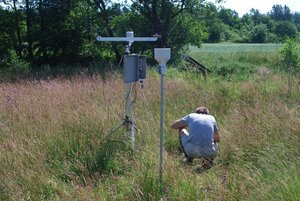The monitoring started in November 2010 i.e. 13 months before the restoration took place and ended in December 2012. Four monitoring stations, were positioned in the river, within the project area, in order to measure the water inflow and the water outflow of the study site (see map of the restoration project). The four stations were recording water level continuously and were equipped with refrigerated automatic sampler collecting composite water samples (see below). The water samples were collected every fortnight and analysed for total phosphorus (TP), total nitrogen (TN), nitrate (NO3-) and suspended matter. Furthermore, to study the hydrological and bio-geochemical processes in the riparian area, more than 100 piezometers (see below) were installed. The groundwater level in the piezometers was recorded continuously and water samples were collected every month. The groundwater samples were analysed for ammonium (NH4+), chloride (Cl-), NO3-, Sulfate (SO42-), and dissolved inorganic phosphorus. The emission of greenhouse gases was also recorded before and after the restoration.

Photo: Joachim Audet
The emission of greenhouse gas was measured using the static chamber technique where fluxes of gas are determined by sampling the concentration of gas over time (generally 1 hour).

Photo: Peter M. Andersen
Piezometers were inserted into the soil to allow the sampling of groundwater and to measure the level of the groundwater. Piezometer are tubes equipped with a filter to let groundwater infiltrate inside the tube.




Photos: Peter M. Andersen
To monitor nutrient concentration in the stream a time-proportional ISCO® sampler was installed. This equipment enables sampling of stream water at pre-defined time interval (e.g. every hours). The water samples are then stored in refrigerated bottles. The station presented in the picture was powered using solar panels. In winter, a methanol power-generator was also used to compensate for the lack of sun.